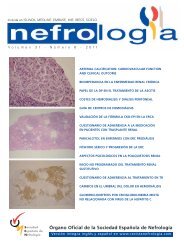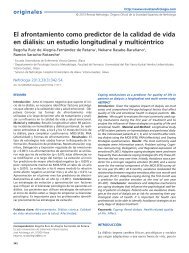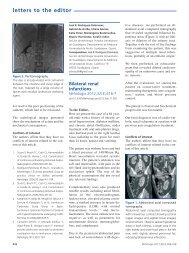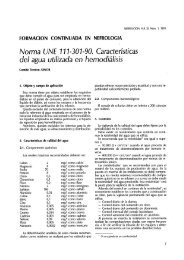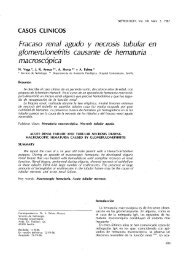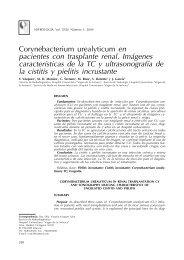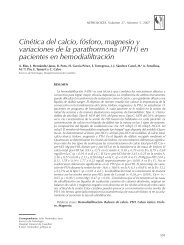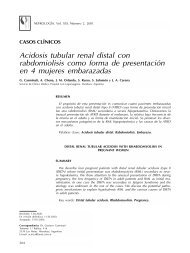PDF Número - NefrologÃa
PDF Número - NefrologÃa
PDF Número - NefrologÃa
You also want an ePaper? Increase the reach of your titles
YUMPU automatically turns print PDFs into web optimized ePapers that Google loves.
cartas al director<br />
Figure 2. PAS stain shows a<br />
fibrocellular crescent in the urinary<br />
space that compresses the residual<br />
glomerulus and its tuft (PAS, x 400).<br />
Dear Editor,<br />
We were very interested by the comment<br />
submitted by Dr. Gioacchino Li Cavoli<br />
and his collaborators, regarding their<br />
similar experience of a membranous<br />
glomerulonephritis with crescentic overmary<br />
membranous glomerulonephritis.<br />
Vasculitic or crescentic glomerulonephritis<br />
is rarely seen in membranous<br />
nephropathy, except in those cases associated<br />
with systemic lupus. The immunopathogenesis<br />
of this unusual transformation<br />
is unclear. It is well recognized<br />
that patients with a crescentic glomerulonephritis<br />
have severe and often rapidly<br />
deteriorating failure. Unlike membranous<br />
nephropathy, which often has an insidious<br />
course progressing to renal failure<br />
over a period of years, patients with<br />
superimposed crescentic glomerulonephritis<br />
appear to have a more aggressive<br />
clinical course. The importance of<br />
recognizing this group of patients with<br />
membranous nephropathy and crescentic<br />
glomerulonephritis is that immunosuppressive<br />
therapy may ameliorate the progression<br />
of renal damage and in some<br />
cases early treatment was associated with<br />
useful recovery of renal function. 4 In our<br />
case, the discontinuation of prednisone<br />
and azathioprine therapy may have facilitated<br />
the rapid progression of kidney<br />
disease.<br />
Conflict of interest<br />
The authors declare that there is no conflict<br />
of interest associated with this<br />
manuscript.<br />
1. Zhou GY. Membranous glomerulonephritis<br />
associated with myeloperoxidase antineutrophil<br />
cytoplasmic antibody-associated<br />
glomerulonephritis.<br />
Nefrologia<br />
2012;32(4):548-51.<br />
2. Kwan JT, Moore RH, Dodd SM,<br />
Cunningham J. Crescentic transformation<br />
in primary membranous<br />
glomerulonephritis. Postgrad Med J<br />
1991;67:574-6.<br />
3. Tse WY, Howie AJ, Adu D, Savage CO,<br />
Richards NT, Wheeler DC, et al.<br />
Association of vasculitic<br />
glomerulonephritis with membranous<br />
nephropathy: a report of 10 cases.<br />
Nephrol Dial Transplant 1997;12:1017-27.<br />
4. Nasr SH, Said SM, Valeri AM, Stokes MB,<br />
Masani NN, D'Agati VD, et al.<br />
Membranous glomerulonephritis with<br />
ANCA-associated necrotizing and<br />
crescentic glomerulonephritis. Clin J Am<br />
Soc Nephrol 2009;4:299-308.<br />
Gioacchino Li Cavoli 1 , Angelo Ferrantelli 1 ,<br />
Luisa Bono 1 , Calogera Tortorici 1 , Carlo<br />
Giammarresi 1 , Rita Passantino 2 ,<br />
Ugo Rotolo 1<br />
1<br />
Division of Nephrology. Civic and Di Cristina<br />
Hospital. Palermo (Italy)<br />
2<br />
Anatomical Pathology Department. Civic<br />
and Di Cristina Hospital. Palermo (Italy)<br />
Correspondence: Gioacchino Li Cavoli<br />
Division of Nephrology. Civic and Di Cristina<br />
Hospital. Via Francesco Cilea 43.<br />
90144 Palermo, Italy.<br />
gioacchinolicavoli@libero.it<br />
Respuesta<br />
Response to “Comment<br />
on 'Membranous<br />
glomerulonephritis<br />
associated with<br />
mieloperoxidase<br />
antineutrophil<br />
cytoplasmic antibody<br />
associated<br />
glomerulonephritis'”<br />
Nefrologia 2013;33(1):136-7<br />
doi:10.3265/Nefrologia.pre2012.Oct.11763<br />
lap. First of all, we would like to thank<br />
them for their input.<br />
They reported a case of membranous<br />
glomerulonephritis (MGN) with crescentic<br />
transformation in a ANCA-negative<br />
vasculitis which revealed no evidence of<br />
systemic lupus erythematosus (SLE),<br />
anti-glomerular basement membrane<br />
(GBM) glomerulonephritis, infection,<br />
malignancy and showed no improvement<br />
after immunosuppressive treatments. The<br />
case they presented was similar to the patient<br />
that Kwan JT et al. described previously.<br />
1 Although several authors have<br />
demonstrated the concomitance of MGN<br />
and ANCA-associated glomerulonephritis,<br />
2-6 MGN accompanied by ANCAnegative<br />
crescentic glomerulonephritis<br />
has been rarely encountered.<br />
The light microscopic visualization of<br />
renal tissue in their case showed the formation<br />
of 11 crescents (3 cellular crescents,<br />
1 fibrocellular crescent and 7 fibrotic<br />
crescents) and 11 out of 17<br />
glomeruli were globally sclerotic. These<br />
histopathological changes indicate the<br />
patient has reached to an advanced stage<br />
of crescentic glomerulonephritis and the<br />
renal disease has progressed to the sclerotic<br />
phase at the time of renal biopsy.<br />
Nasr SH et al. reported that the percentage<br />
of globally sclerotic glomeruli correlated<br />
with nonresponse to immunosuppressive<br />
agents. 5 This is why the<br />
patient showed no improvement after<br />
treated with steroid plus cyclophosphamide<br />
and started chronic haemodialysis<br />
treatment eventually. By contrast,<br />
our case showed 2 sclerosed glomeruli<br />
out of 19 glomeruli, the formation of 9<br />
crescents including 4 cellular crescents<br />
and 5 fibrocellular crescents, as well as<br />
the fibrinoid necrosis lesions upon light<br />
microscopy. This indicates our patient<br />
might be at the relatively early stage of<br />
crescentic glomerulonephritis and the<br />
renal biopsy findings may interpret the<br />
better response to immunosuppressive<br />
treatments in our case.<br />
Concerning the prognosis of this group<br />
of patients, Nasr SH et al. reported that<br />
50% of patients had reached endpoints<br />
of end-stage renal stage (ESRD) or<br />
136 Nefrologia 2013;33(1):134-54



